Related Research Articles

The Mariposa War, also known as the Yosemite Indian War, was a conflict between the United States and the indigenous people of California's Sierra Nevada in the 1850s. The war was fought primarily in Mariposa County and surrounding areas, and was sparked by the discovery of gold in the region. As a result of the military expedition, the Mariposa Battalion became the first non-indigenous group to enter Yosemite Valley and the Nelder Grove.
James D. Savage (1823–1852) was a California pioneer. He was a 49er, businessman, American soldier in the Mexican–American War, and commander of the California Militia, Mariposa Battalion in the Mariposa War and the first alleged non-Native American visitor to the Yosemite Valley.

Harry Love was the head of California's first state-wide law enforcement agency, the California Rangers, and became famous for allegedly killing the notorious bandit Joaquin Murrieta. The California Rangers were also considered to be part of California's early state militia, the predecessor to the current California Army National Guard, with Love holding the rank of Captain within the state.
Thomas Jefferson Mayfield (1843–1928) led a remarkable double life in the early decades of California statehood, living his boyhood as an adopted member of the Choinumni (Choinumne) branch of the Yokuts tribe in the San Joaquin Valley, then rejoining the dominant Anglo-American community throughout his long adulthood.

Mason Frakes Dalton, also known as William Marion "Bill" Dalton, was an outlaw in the American Old West. He was the co-leader of the Wild Bunch gang and with his brothers Gratton, Bob and Emmett Dalton was a member of the Dalton Gang.
Visalia, California, commonly known in the 1850s as Four Creeks, is the oldest continuously inhabited inland European settlement between Stockton and Los Angeles. The city played an important role in the American colonization of the San Joaquin Valley as the county seat of Old Tulare County, an expansive region comprising most if not all of modern-day Fresno, Kings, and Kern counties.
John Hicks Adams (1820–1878) was an American 49er of the California Gold Rush and sheriff of Santa Clara County between 1864 and 1870, and again between 1871 and 1875. He was also Deputy United States Marshal for the Arizona Territory 1878, and a noted gunslinger.
John Mason, with Jim Henry, was one of the leaders of the Mason Henry Gang organized by secessionist Judge George Gordon Belt. The group posed as Confederate partisan rangers, but acted as outlaws, committing robberies, thefts and murders in the San Joaquin Valley, Monterey County, Santa Clara County, Santa Cruz County and later in the counties of Southern California.

The Life and Adventures of Joaquín Murieta: The Celebrated California Bandit (1854) was published by John Rollin Ridge, writing as "Yellow Bird". It is considered to be one of the first novels written in California and the first novel to be published by a Native American. The novel describes the life of a legendary bandit named Joaquín Murrieta who was once a dignified citizen of Mexico. The protagonist becomes corrupt after traveling to California during the California gold rush.

The Owens Valley War was fought between 1862 and 1863 by the United States Army and American settlers against the Mono people and their Shoshone and Kawaiisu allies in the Owens Valley of California and the southwestern Nevada border region. The removal of a large number of the Owens River indigenous Californians to Fort Tejon in 1863 was considered the end of the war. Minor hostilities continued intermittently until 1867.
The Stockton–Los Angeles Road, also known as the Millerton Road, Stockton–Mariposa Road, Stockton–Fort Miller Road or the Stockton–Visalia Road, was established about 1853 following the discovery of gold on the Kern River in Old Tulare County. This route between Stockton and Los Angeles followed by the Stockton–Los Angeles Road is described in "Itinerary XXI. From Fort Yuma to Benicia, California", in The Prairie Traveler: A Hand-book for Overland Expeditions by Randolph Barnes Marcy. The Itinerary was derived from the report of Lieutenant R. S. Williamson on his topographical survey party in 1853, that was in search of a railroad route through the interior of California.

The Mason Henry Gang were bandits operating in Central and Southern California between 1864 and 1865. As the American Civil War was in progress, they were able to pose as Confederate Partisan Rangers, and their original mission was to rid the area of (anti-slavery) Republicans. But when it became clear that the Confederate cause was lost, they turned to outlawry, plundering and killing without mercy.
Frank Forrest Latta (1892–1983), was a California historian and ethnographer of the Yokuts people. He also wrote histories of the early European-American settlement of the San Joaquin Valley.
William Mayfield (1810–1862) was an American pioneer in Illinois, Texas, and California; a soldier, farmer, miner, and a cattleman. He led Tulare County militia to aid settlers in the early part of the Owens Valley Indian War and was killed in the Battle of Mayfield Canyon.
Joaquin Jim was an Eastern Mono, war leader of the Owens Valley Indian War. Joaquin Jim, implacable war leader of the Mono allies of the Owens Valley Paiute, never surrendered to American forces or made peace with them, but reported to have ceased warfare against them in 1864.
The California Indian Wars were a series of wars, battles, and massacres between the United States Army, and the Indigenous peoples of California. The wars lasted from 1850, immediately after Alta California, acquired during the Mexican–American War, became the state of California, to 1880 when the last minor military operation on the Colorado River ended the Calloway Affair of 1880.
The Tule River War of 1856 was a conflict where American settlers, and later, California State Militia, and a detachment of the U. S. Army from Fort Miller, fought a six-week war against the Yokuts in the southern San Joaquin Valley.
Camp Babbitt was an American Civil War Union Army camp located in two sites in the vicinity of Visalia, California.

Peter Lebeck was an early settler of Kern County, California. The only certain information known about him is that he was killed by a bear, probably a California grizzly, and buried underneath a valley oak in 1837. The tree he was buried under is known as the Peter Lebeck Oak. He is attested only by his grave marker, now at Fort Tejon, but the unknown circumstances of his identity and death have cemented his position in the culture of the San Joaquin Valley. He represents the earliest known victim of a bear attack in California.
Savage Trading Post is California Historical Landmark No. 527 in El Portal, California on California State Route 140 in Mariposa County. James D. Savage was 49er California Gold Rush miner and trader, in 1849 he built a Log cabin. In the Log cabin, he started a general store and trading post along the Merced River. After just one year the Mariposa War started. In the spring of 1850 James (Jim) Savage started trading at Mariposa Creek in the San Joaquin Valley and he had employees run his Trading Post. In December 1850 the war came to Savage Trading Post and it was set on fire. James Savage was the leader of the California Militia's Mariposa Battalion that traveled to the Yosemite Valley in 1851 to hunt down the Ahwaneechees and their leader Chief Tenaya. The Mariposa Battalion won the battle and thus ended the war. The Mariposa Battalion also became the first non-Native American to see the beauty of Yosemite Valley. Lafayette Bunnell wrote about his visit to the Yosemite Valley. A copy of Savage Trading Post was built at the site of the original and is California Historical Landmark No. 527.
References
- 1 2 1850 Census, Mariposa County, CA, p. 47 Nov. 13, 1850
- 1 2 3 Thomas J. Mayfield, Indian summer: traditional life among the Choinumne Indians of California's San Joaquin Valley, Heyday Books, Berkley, 1993, p. 25.
- ↑ Brazos County Early Marriages: William Mayfield to Mary Ann Curd, 16 Mar 1848 [ permanent dead link ]
- ↑ Mayfield, Indian summer, pp. 26–27.
- ↑ Mayfield, Indian summer, pp. 26–42.
- ↑ The November 13, 1850 census, shows Mayfield 40 with $10,000 in property and his son John 20 as miners. His son Ben 16 (should be 18) is listed separately with Mary 20 and her child S [or T] Willson Mayfield 7, presumably at the cabin. 1850 Census, Mariposa County, CA, p. 49 Nov. 13, 1850
- ↑ [Mayfield, Indian summer, p. 22.]
- 1 2 Daily Alta California, Volume 18, Number 6032, 16 September 1866 — Los Angeles News. The Case of Mayfield in Los Angeles. The Testimony of Mayfield in Relation to the Killing of Mason.
- ↑ Newspaper Abstracts, Stockton Daily Independent, Saturday, 21 April 1866
- ↑ Sacramento Daily Union, Volume 31, Number 4755, 23 June 1866 — News of the Morning.
- ↑ Mayfield, Indian summer, p.42